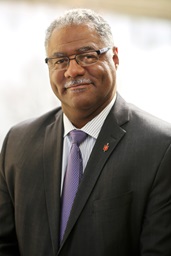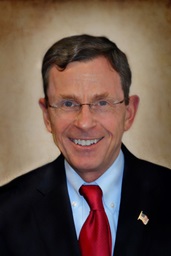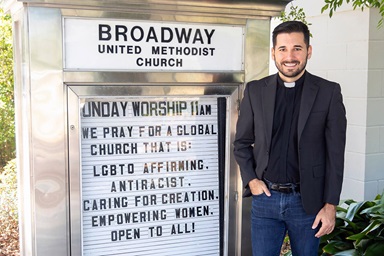The General Conference delegates who meet this month will be charting the future of an international denomination that already looks very different than it did eight years ago when the last regular session General Conference met. In a video, Heather Hahn gives an overview of The United Methodist Church’s homosexuality debate and how the denomination got here.
Transcript:
When General Conference meets in the coming weeks, it will be eight years since The United Methodist Church held the last regular session of its international lawmaking assembly.
The delegates who meet on April 23 through May 3 in Charlotte, North Carolina will be charting the future of an international denomination that already looks very different than it did when General Conference met in 2016.
So how did we get here? I’m Heather Hahn of United Methodist News, and I am here to offer a recap and a look at what’s ahead.
To get a sense of the current situation, it helps to start 52 years ago. That’s when the 1972 General Conference added the statement to our Social Principles that all people are of sacred worth but the practice of homosexuality is and I quote, “incompatible with Christian teaching.”
Before that, the Social Principles and indeed our entire Book of Discipline said nothing one way or the other about homosexuality.
But after 1972, the denomination’s stance on homosexuality became a recurring subject of debate and protest at each General Conference.
The legislative assembly, which typically meets every four years, later added more restrictions. That included banning clergy from officiating at same-sex weddings and banning clergy who are, in the words of the Discipline, “self-avowed practicing homosexuals.” Clergy found guilty of these church-law violations could face loss of credentials or lesser penalties.
But even as a majority of General Conference delegates kept affirming these restrictions, the church bans began to face increasing defiance in some quarters of The United Methodist Church. Simply put, many United Methodists had — and have — different biblical interpretations when it comes to homosexuality.
Meanwhile, United Methodists around the globe operate in very different legal and cultural contexts. Even now, most African countries — including many where The United Methodist Church is growing — have laws criminalizing homosexual activity.
However, in western Europe and the U.S., public attitudes toward LGBTQ people have been shifting. More countries, including the U.S., have legalized same-sex marriage. Increasingly U.S. United Methodist clergy — including a retired bishop — were willing to defy the ban on same-sex weddings.
Also, on the eve of the 2016 General Conference, more than 100 United Methodist clergy and clergy candidates in the U.S. and one in the Philippines came out as gay.
That General Conference, like previous ones, faced legislation to eliminate the bans. The 2016 gathering also faced legislation aimed at increasing accountability and pushing clergy and congregations who disagreed with the bans to leave the denomination.
Matters reached a crisis point during the 2016 General Conference when rumors began swirling that The United Methodist Church was facing an imminent split. That led the delegates to pause consideration of any legislation related to homosexuality and authorize the Council of Bishops to form a commission to find a way forward as a last-ditch effort of keeping the denomination together.
Two other developments in 2016 bear mentioning. That year, the Western Jurisdiction elected Bishop Karen Oliveto, the denomination’s first openly gay and married bishop. The Wesleyan Covenant Association also officially launched as a new traditionalist advocacy group in the denomination. At its first public gathering, the WCA presented a statement to the then-forming Commission on a Way Forward. The WCA’s message: Find a way to hold clergy accountable on matters of homosexuality or prepare for a denominational split.
The Council of Bishops called for a special session of the General Conference in 2019 to take up the Way Forward commission’s proposals.
The commission offered the delegates three possibilities.
- The Connectional Conference Plan, which involved a number of amendments to the denomination’s constitution and never gained much traction.
- The One Church Plan, which would have left matters of ordination up to annual conferences and marriage up to local churches. That plan had the support of many of the denomination’s centrists and progressives.
- Ultimately, delegates chose the Traditional Plan, which prevailed by a vote of 438 to 384. The plan aimed to strengthen enforcement of the ordination and marriage bans, and it is now part of the Discipline.
In a separate vote, the 2019 General Conference also approved a policy allowing churches to leave with property if they met certain procedural and financial obligations. Put a pin in that. It will be important later.
The 2019 General Conference also voted that any legislation it passed would not take effect in central conferences — church regions in Africa, Europe and the Philippines — until 12 months after the close of the next General Conference. At that point, the next General Conference was planned for May 2020.
Whatever United Methodists hoped before the 2019 special session, it soon became clear that the gathering had not ended the debate or the defiance. In opposition to the Traditional Plan, a number of U.S. churches raised rainbow Pride flags outside their buildings. Some local churches bought newspaper ads proclaiming their commitment to the LGBTQ community. United Methodists in Germany declared that they would not enforce the Traditional Plan.
Regardless of how they voted or their personal views, just about everyone present at the 2019 General Conference agreed it was a miserable experience and certainly did not help our Christian witness.
So church leaders moved to talking about a formal denominational separation.
The year 2020 brought 2 big developments for the United Methodist Church. The first was the announcement of the negotiated Protocol of Reconciliation & Grace Through Separation. Under the legislation heading to the coming General Conference, traditional United Methodists would be able to leave The UMC with property and denominational funds to form a new denomination.
The other big development is something we all know about all too well. The onslaught of the COVID pandemic, among other things, halted world travel and led to the postponement of General Conference. Even now, the Protocol has not received a General Conference vote.
And COVID continued to cost lives and disrupt travel. In 2022, after the third postponement of General Conference to now this year, the Wesleyan Covenant Association’s leaders stopped waiting for the Protocol and went ahead and launched the Global Methodist Church.
The launch of the breakaway, theologically conservative denomination saw the acceleration of U.S. church departures under that disaffiliation policy I mentioned that was passed by the 2019 special General Conference. That policy, Paragraph 2553 in the Discipline, expired at the end of last year.
Under the policy, more than 7,600 U.S. churches have disaffiliated — about a quarter of the number of U.S. churches we had in 2019. At least half of those churches have since joined the Global Methodist Church or some other Methodist denomination.
I know one of the big questions people have is: Why are the traditionalists the ones leaving when they are the ones who consistently have prevailed at General Conference?
First, I must clarify that the denomination still has traditionalist members, pastors and bishops.
Florida Conference Bishop Tom Berlin has described the denomination’s dividing line as not between progressives and traditionalists, but between “compatibilists and in-compatibilists.” By that, he means people do not see differences on matters of LGBTQ inclusion as church-dividing and those who do.
As for those who left to join the Global Methodist Church, I think Keith Boyette likely explained it best in 2020 during a discussion of the Protocol. He formerly led the Wesleyan Covenant Association and is now the top executive of the Global Methodist Church.
He noted that the denomination’s progressives and centrists were not voluntarily leaving and so the conflict was bound to continue. He said, “By agreeing to leave, the traditionalists have chosen to set the church free from this conflict.”
The Global Methodist Church plans to hold its convening conference in September.
The United Methodist Church’s big meeting is coming up much sooner this month. Legislation coming before General Conference deals with matters as varied as the denomination’s international structure, a whole package of Revised Social Principles, our ecumenical relations with The Episcopal Church and the denomination-wide budget.
Also on the table will be whether to extend the disaffiliation policy, the number of bishops we should have and a theological statement on why United Methodists have church in the first place. And yes, there will be proposed legislation to lift the denomination’s bans pertaining to marriage and ordination.
We at United Methodist News will be covering developments at General Conference as they happen.
No human knows how General Conference delegates will vote on any issue. But my prayer is that we remember whenever we talk about homosexuality or any church policy that we are ultimately talking about people. We know what Jesus taught us: That the greatest commandments are to love the Lord our God and our neighbors as ourselves. I know these are words we all strive to live by.



